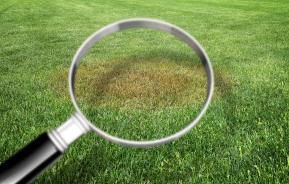Your lawn, just like many of your garden plants, behaves and grows differently across each of the four seasons. Your winter lawn care regime will look quite different from any spring treatments you apply.
Understanding a little about its habits and knowing the simple tricks that will help it flourish can assist you in having a lawn that looks its best year round.
Of course, there are variations in climate and soils depending on where you live, and these need to be considered but here’s our easy guide to seasonal lawn care.
Feeding and watering your lawn across the seasons

Feeding across the seasons
Lawns require regular feeding with a quality fertiliser to keep them looking good and growing strong.
The ideal is to fertilise three times a year – spring, summer and autumn.
Using a quality fertiliser such as Scotts Lawn Builder has many advantages:
- The average lawn will only take around 10-minutes to fertilise.
- One application will last for up to three months.
- As it’s slow release you can rest assured that you are not flooding your soil and surrounding areas with excess nutrient runoff; because the formula is concentrated you get excellent coverage from a small bag.

Watering across the seasons
A well fed, maintained and loved lawn will withstand dry conditions better than a neglected one.
If your lawn is larger than a courtyard and your suburb's water restrictions allow sprinkler systems, then consider changing from hand watering. You'll save yourself loads of time and looking after your lawn becomes quick and easy.
Use a quality lawn sprinkler:
- With an adjustable pattern that can be set to avoid watering hard surfaces.
- Put a timer on your tap so you don’t forget to turn it off.
Lawn care in Spring
Spring is a great time to get your lawn in tip top shape for the upcoming summer BBQ season! If your lawn is looking a bit lacklustre after winter, the following tips will help you whip it into shape.
Tasks:
- Rake vigorously to not only clear fallen leaves and twigs but more importantly; to strip out dead and brown grass ("thatch") to allow more light through to new shoots.
- Fertilise. This is the critical time of year to give your lawn a balanced, slow release feed. Fertilising now provides the nutrients to reinvigorate the lawn so it can power into summer. If you only fertilise once a year, do it in spring!
- Watch watering. This can be a tricky time of year for watering. The soil hasn’t warmed and nights may still be cool, so a deep watering may last for longer than expected. Burrow your finger down into the lawn. If it’s damp, don't water.
- Mowing. Now’s the time to get your mower serviced and the blades sharpened or changed.
- Weed watch. Weeds are coming to life too! Fertilising the lawn to thicken it up will help keep weeds at bay. Very sparse areas are the most likely to become infested with weeds. If they are already obvious, use Scotts Lawn Builder + WeedKill (instead of All Purpose).
ALWAYS read the label to ensure it’s suitable for your lawn type.
Summer lawn care
This is potentially the most challenging time of year for your lawn, with extreme heat, wind and dryness all getting thrown at it. While you can’t do much about the weather, you can make sure your lawn is well set up to survive these trying conditions.
Tasks:
- Fertilise. Apply slow release Scotts Lawn Builder again in early summer - three months after the first feed.
- Get water-wise. Lawns can dry out very quickly in summer. Water early in the morning while it's cool so your lawn gets a chance to absorb the maximum amount of water. Late watering may induce overnight humidity resulting in fungal problems.
- Mowing. Growth usually slows down in hot, dry weather due to stress. Raise the cutting height of the mower to leave the grass longer, providing shade and natural cooling to the roots and soil.
- Weed watch. Weeds may continue to thrive in summer. Remove by hand or try a suitable lawn weed product.
Read the label to make sure it's suitable for your lawn variety before using.
Autumn lawn care
Autumn, along with spring, is the ideal time to do any maintenance on lawns, including patching and re-sowing.
Tasks:
- Fertilise. Feeding now will green your lawn up ahead of winter also make it stronger and better able to resist damage from extreme cold, even frost. Use Scotts Lawn Builder All Purpose at this time of year.
- Watering. It can be easy to overlook the lawn drying out at this time of year. Windy weather can be just as drying as a hot day.
- Mowing. Mowing frequency will decrease as growth slows. In autumn, your lawn is storing energy for winter so and growth/mowing frequency should drop. Ensure you clear leaves to allow your lawn as much sunlight as possible leading into the harsh winter.
Lawn care in Winter
Lawn maintenance over winter is limited, as growth slows in the cooler period.
Tasks:
- Fertilise. Fertilising in winter is not generally recommended, especially if you have already fed it three times since the start of spring. There is little point in feeding because growth has slowed and the lawn will not take up nutrients.
- Watering. The need to water over winter will be low, take care not to over water because a lawn that stays wet can rot when it's cold.
- Mowing. In most places, you’ll probably not need to mow too often over winter. Keep the lawn clear of fallen leaves and trim back overhanging branches that may be restricting light.
- Weed watch. Most weeds are dormant over winter but try to remove any that do crop up, to get a head start for spring!












